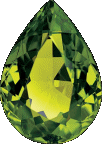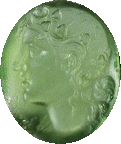| |
Peridot
|
Peridot is crystallized olivine. The name comes from the French peritot witch is in turn a variation of the Arabic faridat, meaning gem. The historical names for peridot were chrysolite and topazos, this has caused some confusion as both names are names currently used for other stones.
Peridot’s historical identity was often conflated by earlier lapidaries. Much of the folklore about peridot are intermingled with the stones we know as emerald, topaz, chrysoberyl, and chrysolite today. For instance, many of the “Moorish emeralds” brought back from the crusades have since been confirmed to be peridot.
It is also very likely that Cleopatra’s famous emerald collection was also peridot. High quality beryls were not mined in Egypt, and Zabargad Island is just off the cost of Egypt. Zabargad is still one of the leading producers of peridot, and was the historical isle of Topazos for which the stone is named. Most green translucent stones were historically called smaragdus, or green gem, which is most often translated as emerald. This may have aided in the conflation as the story was translated into other languages thorough out the centuries.
The folklore that can be positively traced to the modern peridot is none the less interesting. The peridot was associated with the sun. According to legend the gem would shine at night, so the miners would mark the location and dig them the following day. The peridot was a charm against sorcery and nightmares. It had the ability to avert the evil eye, ward off evil spirits, and cast out demons.
|
Colors
|
Various shades of green
|
Locations
|
Australia, Brazil, Burma, China, Egypt, Norway, Pakistan, and the USA
|
Compisition
|
(Mg, Fe)2SiO4, magnesium iron silicate
|
Hardness
|
6.5
|
|

|

|

|
|
|
|
|
|